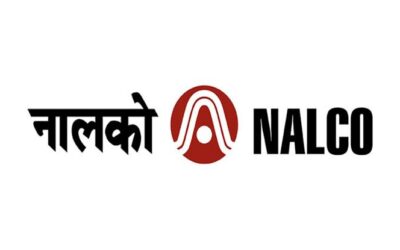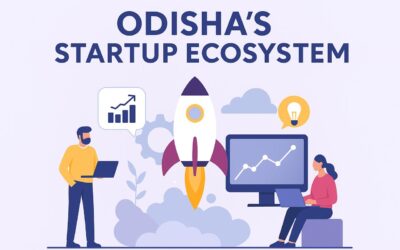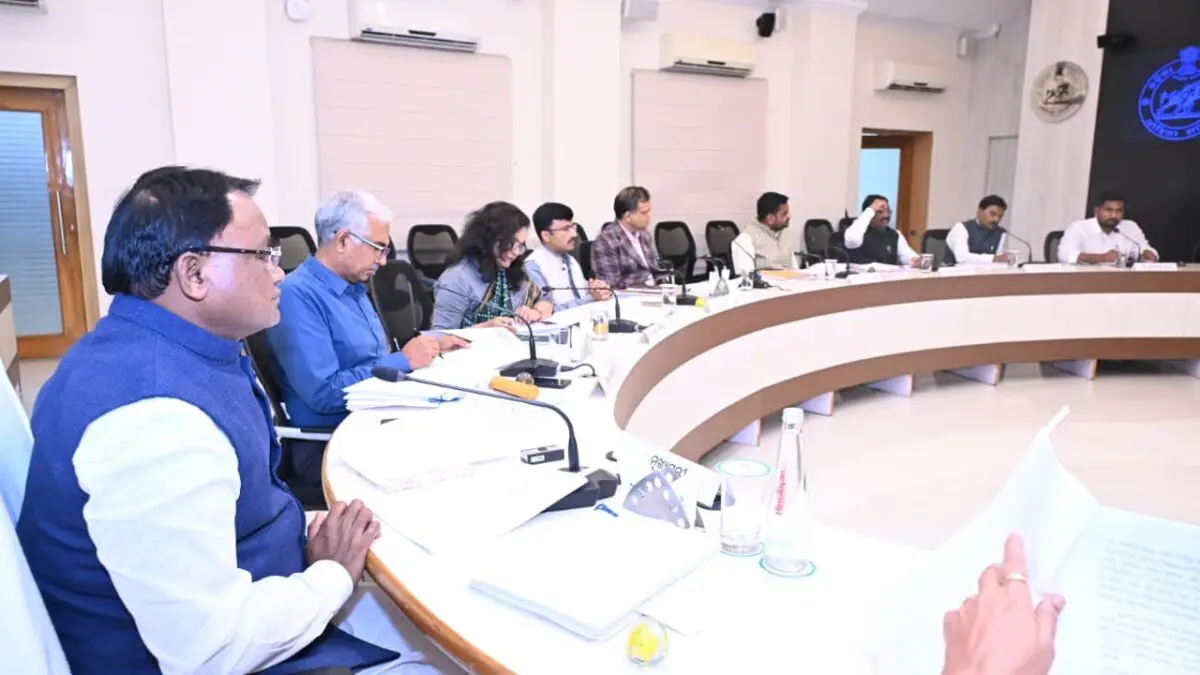The New Odisha: How BJP is Building India’s Next $1.5 Trillion Economy

How Chief Minister Mohan Charan Majhi’s administration is positioning the state as India’s next industrial powerhouse through record-breaking investments, policy reforms, and a $1.5 trillion economy vision

How the Majhi government is transforming the state into India’s next investment hub through policy reforms and strategic economic initiatives
A Year of Economic Transformation
Nearly a year into office, the BJP government in Odisha under Chief Minister Mohan Charan Majhi has demonstrated a clear departure from traditional governance approaches, implementing an aggressive economic transformation strategy that positions the state as India’s next industrial powerhouse. Since assuming office in June 2024, the Majhi administration has pursued a comprehensive reform agenda focused on industrial development, technological advancement, and investment promotion that goes beyond mere policy announcements to tangible structural changes.
The government’s economic philosophy centers on what Chief Minister Majhi describes as creating “a modern hub of industrial and economic activity” where “innovation is encouraged, and business thrives.” This vision is backed by concrete policy frameworks and institutional reforms designed to leverage Odisha’s strategic advantages while building new competitive capabilities across multiple sectors.
Policy Framework and Institutional Reforms
The BJP government has built upon existing foundations while introducing significant policy innovations. The administration has enhanced the acclaimed GO SWIFT (Government of Odisha – Single Window for Investor Facilitation & Tracking) portal system, which had already been recognized as best practice by the Department for Promotion of Industry and Internal Trade. Under the new government, this digital infrastructure has been further streamlined to provide comprehensive one-stop solutions for industrial approvals and clearances.
The portal now facilitates online application submission, payments, tracking, and approval for 32 G2B services from 15 departments, with timelines mandated by the Orissa Right to Public Services Act ensuring time-bound delivery. The government has integrated risk-based synchronized inspections by regulatory agencies and established comprehensive complaint redressal mechanisms, significantly reducing bureaucratic bottlenecks that previously hindered business operations.
A key institutional innovation has been the launch of the ‘Industry Care’ initiative, conducting fortnightly district-wise workshops to raise awareness about business reforms and resolve issues with government departments on a priority basis. This proactive approach demonstrates the government’s commitment to ongoing engagement with the business community rather than passive policy implementation.
Financial Commitment and Resource Mobilization
The BJP government’s maiden budget of ₹2.65 lakh crore for 2024-25 represented a substantial 15% increase from the previous year, signaling serious financial commitment to economic transformation. The budget allocation emphasized inclusive development aligned with Prime Minister Modi’s principles of “Sabka Saath, Sabka Vikas, Sabka Vishwas, Sabka Prayaas.”
Significantly, the government launched the Utkarsh Utkal initiative, replacing the previous Invest Odisha scheme, with enhanced frameworks designed to attract both domestic and international investments. This policy shift reflects a more aggressive and comprehensive approach to investment promotion compared to previous administrations.
Strategic Sectoral Diversification
The Majhi government has strategically positioned Odisha to move beyond its traditional resource-dependent economy toward high-value, skill-driven sectors. The administration’s approach recognizes that sustainable economic growth requires diversification across multiple industries while leveraging existing strengths.
Information Technology and Digital Economy
The government has accelerated Odisha’s emergence as the “Silicon Coast of India” through comprehensive policy frameworks including the Odisha Semiconductor Manufacturing and Fabless Policy-2023, IT Policy-2022, Electronics Policy-2021, and BPO Policy-2021. These policies create a robust ecosystem for technology sector growth, offering competitive incentives while ensuring regulatory clarity.
The state currently hosts over 200 IT firms, including major players like Infosys, TCS, Wipro, and Tech Mahindra. Recent expansion announcements, such as Cognizant’s state-of-the-art 52,000 sqft facility in Bhubaneswar designed to accommodate up to 5,000 associates, demonstrate the sector’s confidence in the state’s new economic direction.
The government’s international engagement strategy has been particularly effective in this sector. A diplomatic mission to Silicon Valley led by the Minister for Electronics and IT successfully showcased Odisha’s potential for semiconductor manufacturing and chip design, garnering significant international interest and positioning the state as a credible alternative to traditional tech hubs.
Manufacturing and Industrial Infrastructure
During its first 100 days, the government prioritized the development of garment manufacturing clusters, food processing parks, and multimodal logistics hubs. These initiatives are strategically designed to strengthen Odisha’s position in global supply chains while creating substantial employment opportunities.
The administration has leveraged the state’s natural advantages, including its 480 km coastline and deep-water ports at Paradip, Dhamra, and Gopalpur, to offer businesses seamless connectivity for imports and exports. This infrastructure advantage, combined with competitive operational costs, positions Odisha favorably against other industrial states.
Tourism and Cultural Heritage
The government has demonstrated significant commitment to tourism development through substantial financial allocations. A corpus fund of ₹500 crore has been created for Shree Jagannath Temple Administration (SJTA), while ₹200 crore has been allocated for Odia Asmita (pride) initiatives. These investments recognize tourism as a key economic driver while preserving the state’s cultural authenticity.
The tourism strategy focuses on comprehensive infrastructure development while leveraging Odisha’s rich heritage, including the world-famous Jagannath Temple, ancient Buddhist sites, and pristine coastline. This balanced approach aims to position Odisha as a premier destination for spiritual, cultural, and eco-tourism experiences.
Investment Attraction and Global Engagement
The government’s investment promotion strategy has yielded substantial results, most notably demonstrated during the Utkarsh Odisha – Make in Odisha Conclave held in January 2025. The event secured investment commitments worth ₹16.73 lakh crore across 593 projects, significantly exceeding the initial target of ₹5 lakh crore and generating employment potential for 12.88 lakh people across 20 sectors.
Major commitments included the Adani Group’s ₹2.3 lakh crore investment pledge over five years across multiple sectors, JSW Group’s ₹35,000 crore steel plant in Keonjhar, and Jindal Steel and Power’s ₹70,000 crore expansion plan for its Angul facility. These commitments represent not just financial investments but strategic partnerships that will transform the state’s industrial landscape.
The government has launched an aggressive international marketing campaign, conducting road shows in major business centers including Mumbai, Hyderabad, Bengaluru, with plans for similar events in Europe and Singapore. This systematic approach to global engagement demonstrates the administration’s understanding that sustainable economic growth requires consistent international outreach rather than episodic promotional activities.
Long-term Vision and Strategic Planning
The government has prepared a comprehensive vision document to make Odisha a developed state by 2036, the centenary year of its formation, with the ultimate goal of creating a $1.5 trillion economy by 2047. This long-term planning approach represents a significant shift from short-term project-based thinking to systematic economic transformation.
Key elements of this vision include developing a metropolitan region comprising Bhubaneswar, Cuttack, Puri, Khurda, Jatni, and Paradip, spread over 7,000 sq km. The government aims to bring all cultivable areas under irrigation while focusing on rapid urbanization as an engine of growth, demonstrating an integrated approach to rural and urban development.
Critical Assessment: Achievements and Challenges
After nearly a year in office, the Majhi government has demonstrated significant achievements in policy formulation, institutional strengthening, and investment attraction. The successful organization of the Utkarsh Odisha Conclave and the overwhelming investor response indicate strong market confidence in the state’s new economic direction.
However, the ultimate test lies in translating policy announcements and investment commitments into operational projects and tangible economic benefits. Chief Minister Majhi has acknowledged this challenge, stating that the government will “set up a mechanism that will work round the clock on how to ground these MoUs and interests into reality,” recognizing that “cost and time over-runs are the two biggest turn-offs for the industry.”
The government’s emphasis on transparency and accountability, combined with regular monitoring mechanisms, suggests a serious commitment to implementation. However, the scale of transformation envisioned requires sustained effort beyond the initial policy framework establishment.
Employment Generation and Skill Development
A critical aspect of the government’s economic strategy focuses on employment generation, particularly for Odia youth. The administration has recognized that industrial development must translate into meaningful job creation to achieve inclusive growth. The government’s approach emphasizes skill development aligned with industry requirements, ensuring that local talent can effectively participate in the state’s economic transformation.
The integration of skill development programs with industrial policy represents a more holistic approach to economic planning compared to previous administrations that often treated these elements separately.
Environmental Sustainability and Green Growth
The government has positioned environmental sustainability as integral to economic development rather than a constraint. The implementation of the Surya Ghar Yojana and focus on renewable energy demonstrate commitment to green growth principles while maintaining industrial competitiveness.
During the Utkarsh Odisha Conclave, discussions on renewable energy highlighted the need for substantial private sector investment in green technologies, with Odisha positioning itself as a leader in sustainable industrial development.
Future Prospects and Strategic Outlook
The BJP government’s economic strategy represents a fundamental paradigm shift toward making Odisha “the growth engine in the country’s development journey over the next twenty-five years.” Through comprehensive policy reforms, aggressive investment promotion, technological advancement, and international partnerships, the administration has established a strong foundation for sustained economic transformation.
The success of initial initiatives, particularly in investment attraction and policy framework development, provides encouraging indicators for the government’s long-term vision. However, the next phase will require consistent execution, effective project monitoring, and adaptive policy adjustments based on implementation experiences.
Conclusion: A New Economic Trajectory
The Mohan Charan Majhi government’s first year demonstrates a clear commitment to transforming Odisha from a resource-dependent economy to a diversified industrial powerhouse. The administration’s comprehensive approach, combining policy innovation, institutional strengthening, and aggressive investment promotion, has created a strong foundation for sustained economic growth.
While the vision of a developed Odisha by 2036 and a $1.5 trillion economy by 2047 remains ambitious, the progress achieved in policy framework development, investment attraction, and institutional reform suggests these goals are achievable with sustained effort and effective implementation.
The government’s success will ultimately be measured not by the scale of investment commitments secured but by their translation into operational projects, employment opportunities, and improved living standards for Odishan citizens. The foundation has been laid; the next phase will determine whether this ambitious economic transformation vision becomes reality.








